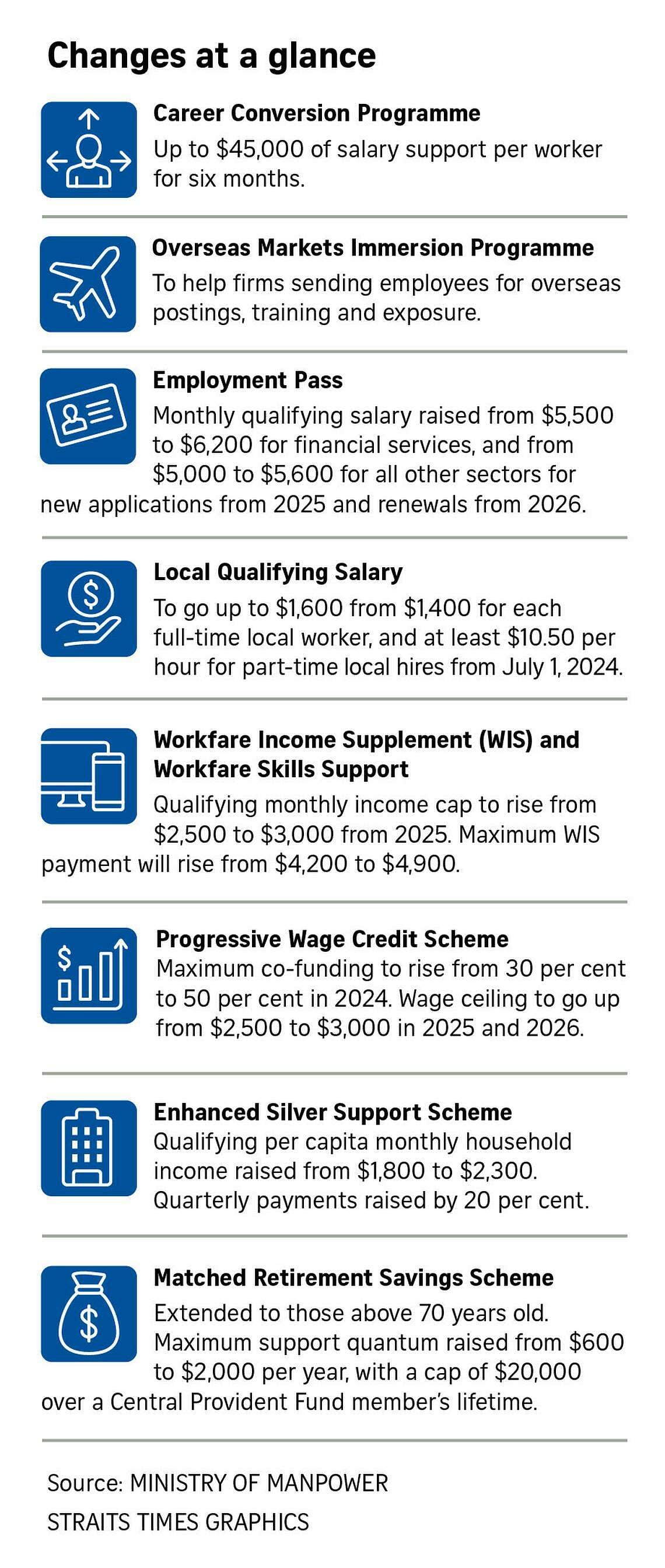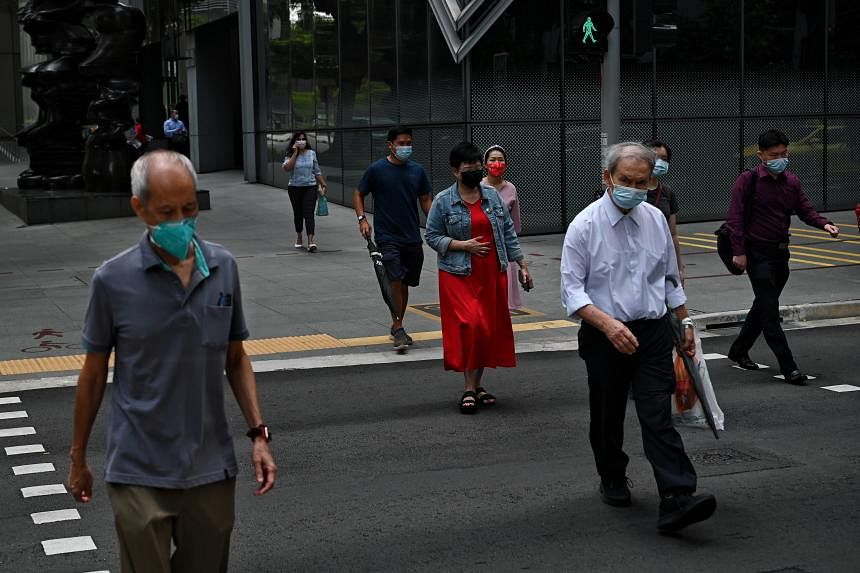SINGAPORE - Workers who want to work longer will have longer statutory protection with the raising of Singapore’s retirement age from 63 to 64 on July 1, 2026.
The re-employment age will likewise go up, from 68 to 69. Companies must offer eligible staff re-employment until that age, though on adjusted terms if necessary, or offer employment assistance in its place.
Minister for Manpower Tan See Leng announced on March 4 the timeline for the move, which was made with consensus among the tripartite grouping of his ministry, unions and employers.
The ceilings were last raised in 2022, after the Government said in 2019 that the retirement age would be increased to 65 and the re-employment age to 70 by the year 2030.
The lead time reflects ground feedback to give businesses and workers ample time to prepare.
Elaborating on the change during the debate on the Ministry of Manpower’s (MOM) budget, Minister of State for Manpower Gan Siow Huang said employers here have mostly been compliant. “Over nine in 10 senior workers who were eligible and wished to continue working were offered re-employment in 2023.”
The onus to hire older workers will not be on employers alone, she said, adding that MOM will support firms to hire older workers and help them update their skills.
Its Part-Time Re-employment Grant gives up to $125,000 for employers who provide these workers with part-time jobs after they reach retirement age, and can also be used to access career training for them. Its Senior Employment Credit scheme offsets wages for workers aged 60 and above.
Singapore, which will have one in four citizens aged 65 and above by 2030, has the third-highest employment rate for workers aged 65 to 69 among countries in the Organisation for Economic Cooperation and Development, Ms Gan said.
Workers in this age bracket are also joining the workforce in greater numbers, lifting the employment rate by 5 percentage points in the last five years to 48.3 per cent in 2023.
Among workers aged between 55 and 64 – the cohort next in line for retirement – the employment rate rose from 66.8 per cent to 70 per cent over the same period.
However, age biases make up about 24 per cent of 315 discrimination complaints filed with the Tripartite Alliance for Fair and Progressive Employment Practices and MOM between 2018 and 2022.
Protecting workers from age-related dismissals before their statutory retirement age is part of the ministry’s efforts to create fair and inclusive workplaces – one of three broad thrusts outlined by Dr Tan for his ministry this work year.
The two others are to boost the employability of local workers and the productivity of businesses, and to shore up retirement adequacy for vulnerable ones.
“Many have asked what keeps me awake at night,” Dr Tan said, adding that near-term headwinds, falling birth rates and an ageing population weigh on the labour market.
“If we do not succeed in sustaining our productivity in the next 10 years, my worry is that we will suffer real declines in economic growth.”
To coax more segments of the population into the workforce, MOM is taking a multi-pronged approach.
Two Bills expected to be passed in 2024 will deter discrimination based on traits such as age, race and disability, as well as protect platform workers.
Guidelines for a clear process on how workers and their bosses should work out flexible work arrangements will also be published in 2024.
In his 45-minute speech, Dr Tan laid out policies aimed at balancing the demands between staying open to foreign talent and making local workers more competitive in the global talent place.
In the latter, the race will not be run by workers alone.
Employers will get help on job redesigning and employee training with four more job transformation maps, on top of the current 16 that already cover 1.5 million local workers. These new maps include two of the latest hot industries – generative artificial intelligence and sustainable finance.
Employers will also get more payroll support under the Career Conversion Programmes (CCPs). They can receive up to $45,000 for each worker for a six-month conversion programme.
The maximum salary support for mature or long-term unemployed workers will be bumped up from $6,000 to $7,500 a month, and for other CCP participants it will be raised from $4,000 to $5,000 a month.
The programme will also be offered to bosses that want to retrain their workers for new roles in the company, and not just workers who are about to face the chopping block.
On efforts to address why few Singaporeans are in global corporate leadership roles, Dr Tan announced that the ministry will help fund employers sending their employees abroad on work stints under a new Overseas Markets Immersion Programme.
This initiative complements the Global Business Leaders Programme led by the Ministry of Trade and Industry, which targets the senior ranks.
For involuntarily unemployed job seekers, the minister reiterated that financial lift to tide them over their job hunt period is being developed.
“We are close to finalising the scheme parameters, and I want to assure the House that we have indeed looked at best practices around the world,” said Dr Tan.
“For example, our payouts will be conditional on job seekers making the effort to actively search for a job.”
Plans to professionalise skilled trades with structured training and career pathways are also being studied, beginning with electricians, said Dr Tan.
There is, however, no intention to legislate retrenchment benefits for tradespeople, he said in response to Leader of the Opposition Pritam Singh’s proposal.
This is consistent with the Government’s approach on retrenchment benefits for all employees, said Dr Tan. Such a move would compromise the viability of businesses already in financial difficulty and put their existing employees at risk, and allow businesses that can afford to pay more to opt for the minimum.
Responding to a suggestion raised by Ms Foo Mee Har (West Coast GRC) during the debate on the Budget, Dr Tan said that exempting CPF members already aged 55 and above from the upcoming closure of the Special Account (SA) will inadvertently create a generational divide.
It would benefit the current generation of older Singaporeans while disadvantaging younger generations, he said.
As he went on to explain the context and impact of the closing of the SA from 2025 for workers aged 55 and up, he added: “We must evolve our CPF system, while retaining its focus on serving the broad majority and providing more support to those with less.”
The planned move, announced in Budget 2024, drew protests from quarters that have been taking advantage of its higher-than-market interest rate with no fixed term.
But only 8,400 members – generally the more well-off, who make up less than 1 per cent of affected members – will not be able to fully transfer their SA savings into their Retirement Accounts (RA), said Dr Tan.
These members have the options to move their monies to the RA of family members, or withdraw them from CPF, he said.
Close to 720,000 CPF members have money in their SA that could be drawn down. Their median withdrawal balance is about $2,000.
If these members move these monies into the equally liquid Ordinary Account (OA), he added, the interest difference is about $3 a month.
Rebutting opposition MPs’ characterisation of retirement adequacy as a “serious and ongoing concern”, Dr Tan said more than seven in 10 active CPF members today have set aside the Full Retirement Sum at age 55 either in cash or in a mixture of property and cash. It was five in 10 a decade ago.
In addition, a slew of top-ups for older, lower-wage earners, homemakers and caregivers are being made to boost their retirement savings. These include the Majulah Package, Workfare Income Supplement, Silver Support Scheme and Matched Retirement Savings Scheme.
Some MPs had proposed letting CPF members use their savings to get better returns: Progress Singapore Party Non-Constituency MP Hazel Poa and Workers’ Party MP Louis Chua (Sengkang GRC) asked about implementing the Lifetime Retirement Investment Scheme, which lets CPF members invest in low-cost lifecycle portfolios that yield higher rates.
Dr Tan added that the ministry is studying it, but warned about introducing risks to retirees’ savings.
He said: “With the benefit of hindsight on historical returns these few years, it is easy to comment on what should have been done. Although the current outlook for 2024 has improved, there is still considerable uncertainty, with risks tilted to the downside.”
Reminding the House of the purpose of the CPF several times, Dr Tan said: “Since we started in 1955, the three core priorities are to fund retirement adequacy for our members, to provide housing and (to provide) healthcare.”
Acknowledging that the OA interest rate has been relatively flat compared with market instruments of comparable risk and duration, Dr Tan said the Government will continue to review it periodically.
However, giving a more enduring comparison, he said: “On average, the OA interest rate was 1.7 percentage points higher than the 12-month fixed deposit rates from 1999 to 2021.”
He also assured the House that the Government will work hard at providing stable returns for Singaporeans’ retirement savings.
Calling on workers to learn new skills and play outside their comfort zone, the minister invoked pop star Taylor Swift in a light-hearted moment, quoting lyrics of her song You Belong With Me: “You tell me about your dreams. Think I know where you belong.”
Said Dr Tan: “(As) it is with Forward SG, we will empower Singaporeans to seize that dream career opportunity by helping them take charge of their careers.”

Correction note: In an earlier version of the story, we said that discrimination complaints were filed with the Tripartite Alliance for Dispute Management and the Ministry of Manpower. This is incorrect. It should be the Tripartite Alliance for Fair and Progressive Employment Practices and the Ministry of Manpower. We are sorry for the error. This story has also been edited for clarity.


